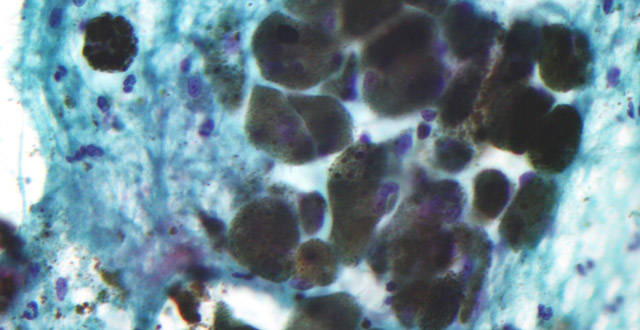Melanin – the pigment that colors skin, eyes and hair – could soon be the face of a new generation of bio-friendly electronic devices used in applications such as medical sensors and tissue stimulation treatments.

Melanin, a dark granular material in the center of image, in a pigmented melanoma (Nephron)
A study, published in the journal Proceedings of the National Academy of Sciences, for the first time gives remarkable insight into the electrical properties of this pigment and its biologically compatible “bioelectronic” features.
“Semiconductors are arguably the most important modern day high-tech material – they drive all modern electronics,” said study co-author Prof Paul Meredith of the University of Queensland. “The majority of semiconductors are made from inorganic elements or compounds such as silicon or gallium arsenide.”
Organic semiconductors, on the other hand, are a relatively new member of the semiconductor family and are composed of molecules containing carbon, hydrogen and other elements.
“There are very few examples of natural organic semiconductors and melanin was thought to be the very first example, demonstrated to be such in the early 70s,” Prof Meredith said.
Co-author Ben Powell, an associate professor at The University of Queensland, said that in semiconductors, such as those found in computers and mobile phones, electrons carry the electrical current. However, in biological systems, such as brains and muscles, ions carry the current.
“We’ve now found that in melanin, both electrons and ions play important roles,” the scientist said.
The study points to a new way of interfacing conventional electronics to biological systems using a combination of ion-and-electron conducting biomaterials such as melanin.
“Melanin is able to ‘talk’ to both electronic and ionic control circuitry and hence can provide that connection role,” said Prof Meredith about the study’s finding, the culmination of ten years of research and experiments. “There are very few materials that meet these compatible bioelectronic requirements, and an insight into melanin’s important biological functions and properties has been really crucial in this study.”
In recent years, the electronics industry has been driven to develop materials and components that are cheaper and more environmentally friendly.
“There is a realization that in many such applications, we should move on from the relatively more expensive inorganic semiconductors. We need cheaper, safer electronic materials with greener credentials,” Prof Meredith said.
“Organic conductors and semiconductors are widely viewed has having enormous potential in this regard, and in the area of medical sensors and devices, biocompatibility will be a key requirement.”
The team is currently working on creating ion-based electrical devices using melanin, with a view to ultimately connect them to actual biological systems.
“A critical area that one could foresee for bioelectronics is stimulating or repairing signal-carrying pathways in tissues such as muscle or brain,” Prof Meredith concluded.
_______
Bibliographic information: Mostert AB et al. 2012. Role of semiconductivity and ion transport in the electrical conduction of melanin. PNAS. Published online before print May 21, 2012; doi: 10.1073/pnas.1119948109







